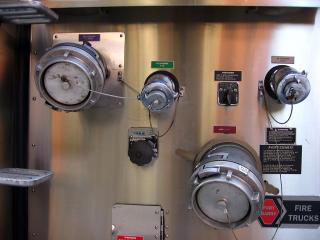[Update: 22 January 2009] Some of the information in the post below is inaccurate. Namely, it implies that some level of continuous emissions is compatible with climate stabilization. In fact, stabilizing climate required humanity to have zero net emissions in the long term. For more about this, see this post.
Every day, new announcements are made about possible emission pathways (X% reduction below year A levels by year B, and so forth). A reasonable number of people, however, seem to be confused about the relationship between emissions, greenhouse gas concentrations, and climatic change. While describing the whole system would require a huge amount of writing, there is a metaphor that seems to help clarify things a bit.
Earth’s carbon bank account
Imagine the atmosphere is a bank account, denominated in megatonnes (Mt) of carbon dioxide equivalent. I realize things are already a bit tricky, but bear with me. A megatonne is just a million tonnes, or a billion kilograms. Carbon dioxide equivalent is a way of recognizing that gasses produce different degrees of warming (by affecting how much energy from the sun is radiated by the Earth back into space). You can think of this as being like different currencies. Methane produces more warming, so it is like British Pounds compared to American dollars. CO2 equivalent is basically akin to expressing the values in the ‘currencies’ of different gasses in the form of the most important one, CO2.
Clearly, this is a bank account where more is not always better. With no greenhouse gasses (GHGs), the Earth would be far too cold to support life. Too many and all the ice melts, the forests burn, and things change profoundly. The present configuration of life on Earth depends upon the absence of radical changes in things like temperature, precipitation, air and water currents, and other climatic factors.
Assuming we want to keep the balance of the account more or less where it has been for the history of human civilization, we need to bring deposits into the account in line with withdrawals. Withdrawals occur when natural systems remove GHGs from the atmosphere. For instance, growing forests convert CO2 to wood, while single celled sea creatures turn it into pellets that sink to the bottom of the ocean. One estimate for the total amount of carbon absorbed each year by natural systems is 5,000 Mt. This is the figure cited in the Stern Review. For comparison’s sake, Canadian emissions are about 750 Mt.
Biology and physics therefore ‘set the budget’ for us. If we want a stable bank balance, all of humanity can collectively deposit 5,000 Mt a year. This implies very deep cuts. How those are split up is an important ethical, political, and economic concern. Right now, Canada represents about 2% of global emissions. If we imagine a world that has reached stabilization, one possible allotment for Canada is 2%. That is much higher than a per-capita division would produce, but it would still require us to cut our present emissions by 83%. If we only got our per-capita share (based on present Canadian and world populations), our allotment would be 24.5 Mt, about 3.2% of what we currently emit. Based on estimated Canadian and world populations in 2100, our share would be 15 Mt, or about 2% of present emissions.
Note: cutting emissions to these levels only achieves stabilization. The balance in the bank no longer changes year to year. What that balance is depends upon what happened in the years between the initial divergence between deposits and withdrawals and the time when that balance is restored. If we spend 100 years making big deposits, we are going to have a very hefty balance by the time that balance has stabilized.
Maintaining a balance similar to the one that has existed throughout the rise of human civilization seems prudent. Shifting to a balance far in excess carries with it considerable risks of massive global change, on the scale of ice ages and ice-free periods of baking heat.
On variable withdrawals
Remember the 5,000 Mt figure? That is based on the level of biological GHG withdrawal activity going on now. It is quite possible that climate change will alter the figure. For example, more CO2 in the air could make plants grow faster, increasing the amount withdrawn from the atmosphere each year. In the alternative, it is possible that a hotter world would make forests dry out, grow more slowly, and burn more. However the global rate of withdrawal changed, our rate of deposit would have to change, as well, to maintain a stable atmospheric balance.
Here’s the nightmare possibility: instead of absorbing carbon, a world full of burning forests and melting permafrost starts to release it. Now, even cutting our emissions to zero will not stop the global atmospheric balance from rising. It would be akin to being in a speeding car with no control of the steering, acceleration, or brakes. We would just carry on forward until whatever terrain in front of us stopped the motion. This could lead to a planetary equilibrium dramatically unlike anything human beings have ever inhabited. There is a reasonable chance that such runaway climate change would make civilization based on mass agriculture impossible.
An important caveat
In the above discussion, greenhouse gasses were the focus. They are actually only indirectly involved in changes in global temperature. What is really critical is the planetary energy balance. This is, quite simply, the difference between the amount of energy that the Earth absorbs (almost exclusively from the sun) and the amount the Earth emits back into space.
Greenhouse gasses alter this balance because they stop some of the radiation that hits the Earth from reflecting back into space. The more of them around, the less energy the Earth radiates, and the hotter it becomes.
They are not, however, the only factor. Other important aspects include surface albedo, which is basically a measure of how shiny the planet is. Big bright ice-fields reflect lots of energy back into space; water and dark stone reflect much less. When ice melts, as it does in response to rising global temperatures, this induces further warming. This is one example of a climatic feedback, as are the vegetation dynamics mentioned previously.
In the long run, factors other than greenhouse gasses that affect the energy balance certainly need to be considered. In the near term, as well demonstrated in the various reports of the IPCC, it is changes in atmospheric concentration that are the primary factor driving changes in the energy balance. Things that alter the Earth’s energy balance are said to have a radiative forcing effect. (See page 4 of the Summary or Policy Makers of the 4th Working Group I report of the IPCC.)
What does it mean?
To get a stable atmospheric balance, we need to cut emissions (deposits) until they match withdrawals (what the planet absorbs). To keep our balance from getting much higher than it has ever been before, we need to do this relatively quickly, and on the basis of a coordinated global effort.




